A brief history of combat optics for assault rifles
- Marco Damaso
- Mar 24, 2024
- 6 min read
Updated: Dec 10, 2024
In this post I will briefly present the history of combat optics for assault rifles from the 70s till today. I will not go into details about the advantages/disadvantages of the various systems as I already described it in my previous blog “How to increase your hit probability in combat”.
1 Single Point OEG
The first use of combat optics on assault rifles probably took place during the Son Tay raid on 21 November 1970. It was the Single Point OEG reflex sight that members of the American special forces installed on an improvised basis on their GAU-5/A assault rifles (COLT XM177).

Single Point OEG
2 L2A2 Sight Unit Infantry Trilux (SUIT)
The SUIT combat optic was introduced into service with the British and Australian armies in the mid-1970s. It was a 4x fixed magnification optic with an inverted chevron reticle (from above).

SUIT combat optic on L1A1 assault rifle
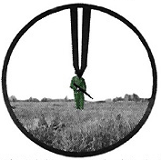
SUIT chevron
3 Optical sights on the Steyr AUG
The Austrian "Sturmgewehr 77 (StG 77)" assault rifle, which entered service in the late 1970s, has a fixed 1.5x magnification optical sight. This would make it the first assault rifle with an integrated optical sight to be used by an army.
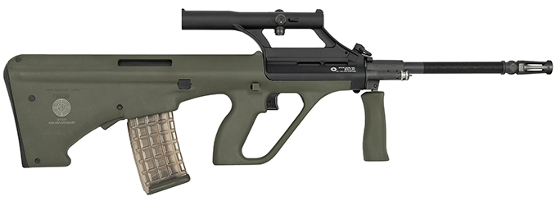
StG 77
4 L9A1 Sight Unit Small Arms, Trilux (SUSAT)
The British Army's L85 rifle, which entered service in the late 1980s (1987), was fitted with combat optics as standard. This was a 4x fixed magnification optic with a chevron reticle (like the SUIT).
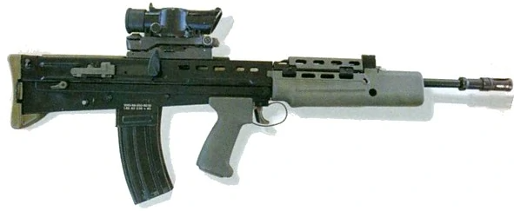
L85 with SUSAT combat optic
5 Aimpoint
In the late 80s and early 90s, various special forces units began installing Aimpoint red dot sights on their assault rifles. Photographs from conflicts such as Panama in 1989 and Mogadishu in 1993 show Aimpoint red dot sights on the assault rifles of Delta Force members.
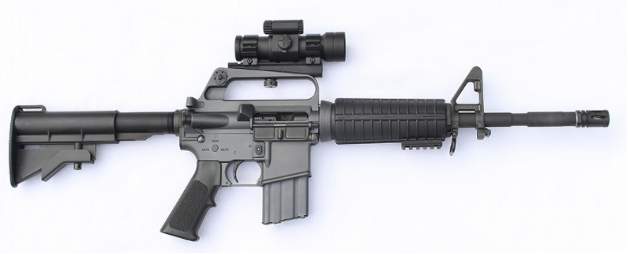
CAR-15 avec Aimpoint 5000
6 C79 optical sight
In 1989, the Canadian Army introduced ELCAN's C79 optical sight for its assault rifles and machine guns. This was a 3.4x fixed magnification sight.
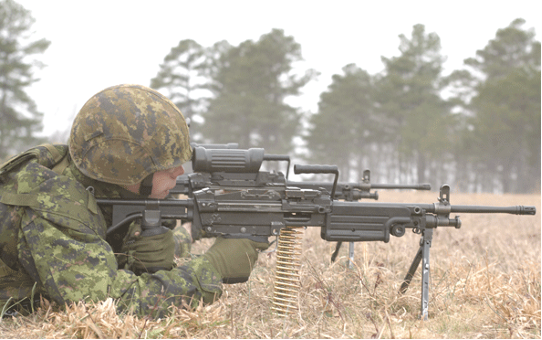
C79 optical sight
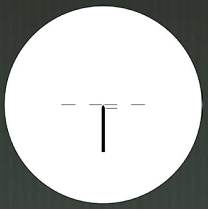
C79 optical sight reticle
7 Variable magnification optics
One of the lessons learned by Delta Force following the battle of Mogadishu in 1993 was the need for variable magnification combat optics (1-3x or 1-4-x). This need was put to various manufacturers of spotting scopes.
The results of this initiative included the LEUPOLD QC/T 1-3x14mm and the SCHMIDT & BENDER CQB Short Dot 1.1-4x20mm. These combat optics had a magnification of almost 1x with a red dot for close combat and a "high" magnification of 3x or 4x with a reticle for combat at greater distances.
One of the main shortcomings of these combat optics was that the (almost) 1x magnification was massively inferior to the red dot sights of the time (e.g. AIMPOINT).
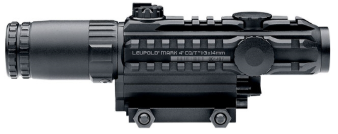
LEUPOLD QC/T 1-3x14mm
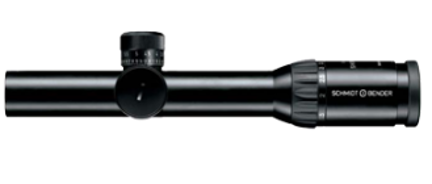
S&B CQB Short Dot 1.1–4x20mm
8 Special Operations Peculiar MODification (SOPMOD)
The US Special Forces SOPMOD kit was introduced into service in the early 1990s (from 1993). The SOPMOD kit at the time included a TRIJICON 4x32 ACOG NSN combat optic and an AIMPOINT Comp M2 red dot sight.
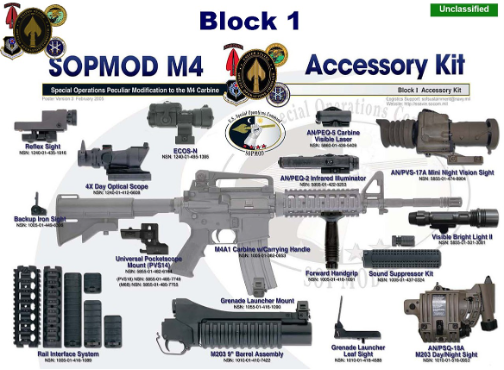
SOPMOD M4 Block 1
9 M68 Close Combat Optic (M68 CCO)
The US Army was the first army to introduce a red dot sight (M68 CCO) across the board.
The M68 CCO red dot sight is in fact a variant of the AIMPOINT CompM2. The AIMPOINT CompM2 was subsequently introduced in various other armies.
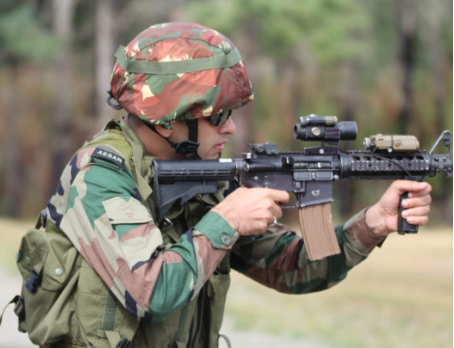
M68 CCO
10 SOPMOD Block 1.5 und 2
The US Special Forces SOPMOD kit has been adapted over the years with new products.
The AIMPOINT CompM2 red dot sight will be replaced by the EOTech 553. The TRIJICON 4x32 ACOG NSN combat optic was replaced by the TRIJICON 4x32 ACOG TA01 ECOS in the Block 1.5 upgrade.
A DOCTOR RDS mini red dot sight was added to the TRIJICON ACOG TA01 ECOS combat optic in the Block 2 upgrade. A few years later, the DOCTOR RDS mini red dot sight was replaced by the TRIJICON RMR.
In addition, the ELCAN Specter DR 1x/ 4x Scope combat optic was added to the SOPMOD kit. This has 1x and 4x magnification, which can be switched using a side lever. It also has an emergency sight that can be replaced by a mini red dot sight.
In recent years, many armies have introduced optical sights for their assault rifles. These are the main variants:
- Red dot sight (with or without additional magnification module);
- 3.5x or 4x magnification combat sights (with or without additional mini red dot sight);
- combat optics with permutable 1x and 4x magnification.
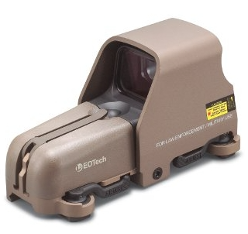
EOTech 553
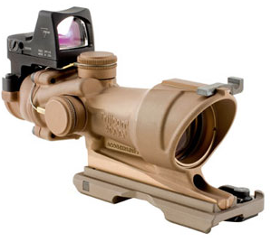
TRIJICON ECOS avec RMR
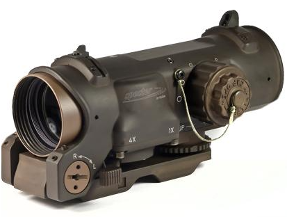
ELCAN Specter 1x/ 4x
11 Magnifiers (Boosters)
Around the turn of the millennium, probably in connection with the conflict in Afghanistan, it was recognized that red dot sights were only moderately suitable for detecting, identifying, and combating targets at longer distances.
Manufacturers of red dot sights then developed magnifiers to counter this problem (generally with 3x magnification).
These magnifiers make up for some of the shortcomings of red dot sights. However, the magnification also increases the size of the red dot, which will cover/be larger than the target from a certain distance. In addition, the ability to reflexively engage the weapon/sight is greatly reduced, as the supplementary magnification module requires the eye to be aligned in a similar way to combat optics.
Magnifiers are installed behind the red dot sight, usually on a quick release and/or tilt mount.
The latest models are also available with 4x or 6x magnification and dioptric adjustment.
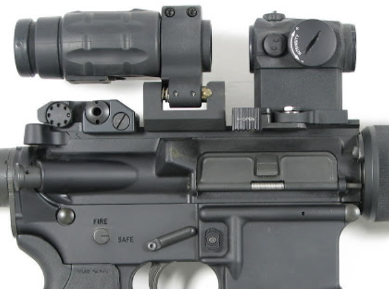
Magnifier
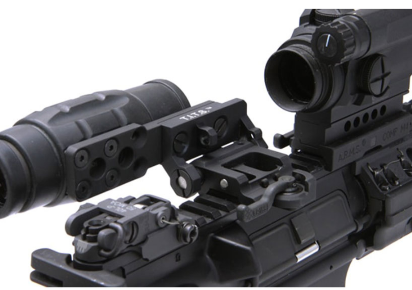
Magnifier with side-flip mount
12 Low Power Variable Optics (LPVO)
Low Power Variable Optics (LPVO) have developed rapidly in recent years. These generally have a real 1x magnification and are virtually equivalent to red dot sights for close combat. What's more, the magnification can be increased continuously up to 10x (depending on the model).
The current models have an excellent performance/weight/size ratio and can be used as standard combat optics on assault rifles.
LPVOs also feature very complete (and sometimes complicated) reticles, with ballistic or thousandths compensation, further enhancing the scope's performance.
In 2019/2020, the US Special Forces put two LPVO models into service for their SOPMOD kit (NIGHTFORCE ATACR 1-8x24 F1 and SIG SAUER TANGO6 1-6x24 F2), and in 2021 the US Marine Corps chose an LPVO (TRIJICON VGOG 1-8x28) as the standard combat optic for their assault rifle.
With an LPVO, the soldier has the ability to detect, identify and combat targets at ranges from 0 to 500/ 600m.
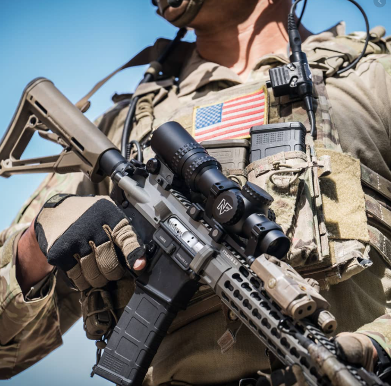
SOCOM NIGHTFORCE ATACR 1-8x24 LVPO
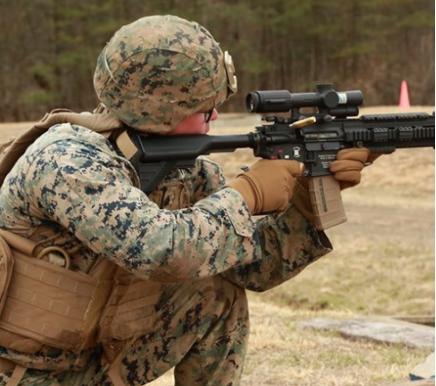
USMC TRIJICON VGOG 1-8x28 LPVO
13 Fire Control
The L3 and VORTEX NGSW-FC fire control systems had been selected as part of the evaluation of the US Army's new Next Generation Squad Weapon (NGSW) assault rifle and machine gun and the VORTEX NGSW-FC has been chosen.
These firing control systems are based on variable magnification optics from 1x to 8x and incorporate a LASER rangefinder (1km), atmospheric and angle sensors and a firing calculator that provides the firing solution based on distance, atmospheric pressure, temperature, and firing angle.
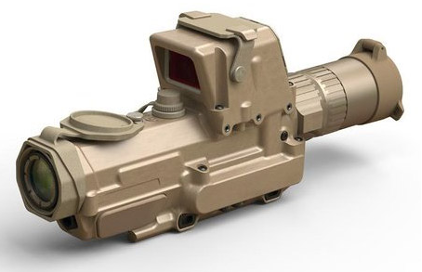
NGSW-FC from L3
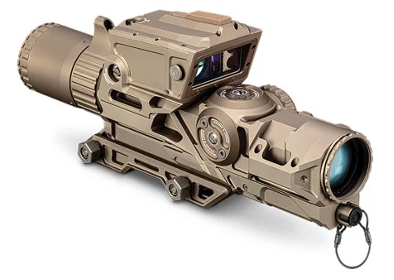
NGSW-FC from VORTEX
14 Conclusion
Combat optics for assault rifles have undergone considerable development over the last 50 years, largely because of lessons learned and experience gained in modern conflicts.
For the dismounted combatant, who must detect, identify, and fight targets between 0 and 400/ 600m, it seems that today an LPVO with a magnification of up to 6x or 8x is today’s benchmark.
Red dot sights can still offer advantages for units that have to fight very dynamically in confined spaces (e.g. hostage rescue). However, the inherent disadvantages must be weighed up once the units have left the buildings.
The current trend seems to be towards optical fire control systems. Systems with a digital channel (camera) have not yet proved their worth, particularly in low light or when there are rapid changes in light conditions (e.g. getting out quickly, observing or shooting from a dark house to the outside during the day).
Another aspect, and not the least, is the cost of combat optics. Here is a range for tried-and-tested military models:
- Red dot sight - Red dot sight with booster - 4x combat optics - 4x combat optics with mini red dot sight - LPVO - Fire control | $ 500 – 750 $ 1’000 – 2’000 $1’000 – 2’000 $ 1’500 – 2’500 $ 2’000 – 5’000 $ 10’000 – 15’000 |
コメント